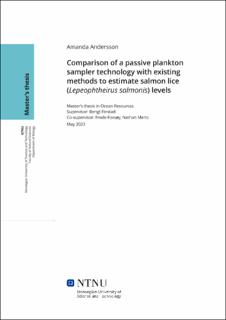| dc.contributor.advisor | Finstad, Bengt | |
| dc.contributor.advisor | Fossøy, Frode | |
| dc.contributor.advisor | Mertz, Nathan | |
| dc.contributor.author | Andersson, Amanda. | |
| dc.date.accessioned | 2023-07-04T17:22:13Z | |
| dc.date.available | 2023-07-04T17:22:13Z | |
| dc.date.issued | 2023 | |
| dc.identifier | no.ntnu:inspera:141153294:44525106 | |
| dc.identifier.uri | https://hdl.handle.net/11250/3075880 | |
| dc.description.abstract | Lakselus (Lepeophtheirus salmonis) er sett på som en av de største utfordringene for industriell vekst innen Norsk akvakultur industri. Det er vanskelig å bestemme eksakte lakselus-nivåer i sjøen på grunn av den dynamiske naturen. Det er derfor behov for en bred variasjon av metoder for å kunne administrere balansen mellom natur og industri. Den passive planktonsamleren (PPS), er en ny teknologi som gjør det mulig å samle inn bulkplanktonprøver over flere dager.
Hensikten med dette studiet var å sammenligne PPS med et utvalg metoder som brukes i dag for å estimere lusenivåer i sjøen. Metodene som blir sammenlignet er et horisontalt slept planktonnett, Havforskningsinstituttet (HI) sin spredningsmodell og HI sine vaktbur. Innsamlingen av plankton foregikk i perioden mai og juni i 2022 i Hardangerfjorden.
Gjennom studiet er det undersøkt evnen PPS innehar når det gjelder å samle inn plankton i felt. Metodene det sammenlignes med er ulike, men det er fortsatt noen tegn til korrelasjon og like trender. PPS korrelerte mest med HI sin modell med en korrelasjons koeffisient (rho) på 0,46. Med planktonnettet var det en rho på 0,33 og med HI sine vaktbur en rho på 0,28. Denne studien viser noen lovende indikasjoner på at PPS har potensial for denne typen feltprøvetaking, men det er fortsatt behov for mer utvikling og testing for å finne ut hvordan PPS kan bidra. Den kan potensielt bidra med å støtte de andre metodene brukt som et reguleringsverktøy i dag når det kommer til den nasjonale lakselusovervåkningen (NALO) programmet eller Trafikklyssystemet. | |
| dc.description.abstract | Salmon lice (Lepeophtheirus salmonis) is considered one of the biggest obstacles for industrial growth of the Norwegian aquaculture industry. It is difficult to determine the exact number of salmon lice in the sea due to their dynamic nature. Therefore, there is need for a broad variation of methods to be able to manage the balance between nature and industry. The passive plankton sampler (PPS) is a new technology, enabling collection of bulk plankton samples over several days.
The purpose of this study was to compare the PPS to a selection of methods that are being used today to estimate lice levels in the sea. The methods that are being compared are a horizontally towed plankton net, the Institute of Marine Research’s (IMR) model and IMR’s sentinel cages. The collection of plankton was performed in the period May and June of 2022 in the Hardangerfjord.
Through the study, the ability of the PPS has been investigated when it comes to collecting plankton in the field. The methods compared are different, but there are some signs of correlation and similar trends. The PPS correlates most with the IMR model with a correlation coefficient (rho) of 0,46. With the plankton net there was a rho of 0,33 and with the sentinel cages a rho of 0,28. This study shows some promising indications that the PPS has potential for this kind of field sampling but there is still need for more development and testing to determine how the PPS can contribute. Potentially it could support the other methods used today as a managing tool when it comes to the Norwegian surveillance program for salmon lice (NALO) programme or the Traffic Light System. | |
| dc.language | eng | |
| dc.publisher | NTNU | |
| dc.title | Comparison of a passive plankton sampler technology with existing methods to estimate salmon lice (Lepeophtheirus salmonis) levels | |
| dc.type | Master thesis | |
